The kinase domain of CK1 enzymes contains the localization cue essential for compartmentalized signaling at the spindle pole
- PMID: 29742018
- PMCID: PMC6080649
- DOI: 10.1091/mbc.E18-02-0129
The kinase domain of CK1 enzymes contains the localization cue essential for compartmentalized signaling at the spindle pole
Abstract
CK1 protein kinases contribute to multiple biological processes, but how they are tailored to function in compartmentalized signaling events is largely unknown. Hhp1 and Hhp2 (Hhp1/2) are the soluble CK1 family members in Schizosaccharomyces pombe. One of their functions is to inhibit the septation initiation network (SIN) during a mitotic checkpoint arrest. The SIN is assembled by Sid4 at spindle pole bodies (SPBs), and though Hhp1/2 colocalize there, it is not known how they are targeted there or whether their SPB localization is required for SIN inhibition. Here, we establish that Hhp1/2 localize throughout the cell cycle to SPBs, as well as to the nucleus, cell tips, and division site. We find that their catalytic domains but not their enzymatic function are used for SPB targeting and that this targeting strategy is conserved in human CK1δ/ε localization to centrosomes. Further, we pinpoint amino acids in the Hhp1 catalytic domain required for SPB interaction; mutation of these residues disrupts Hhp1 association with the core SPB protein Ppc89, and the inhibition of cytokinesis in the setting of spindle stress. Taken together, these data have enabled us to define a molecular mechanism used by CK1 enzymes to target a specific cellular locale for compartmentalized signaling.
Figures

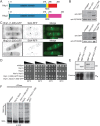
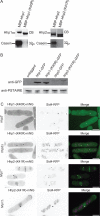
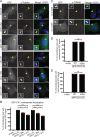
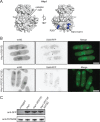

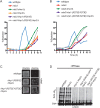
Similar articles
-
New mutations in the core Schizosaccharomyces pombe spindle pole body scaffold Ppc89 reveal separable functions in regulating cell division.G3 (Bethesda). 2025 Jan 8;15(1):jkae249. doi: 10.1093/g3journal/jkae249. G3 (Bethesda). 2025. PMID: 39471327 Free PMC article.
-
Ppc89 links multiple proteins, including the septation initiation network, to the core of the fission yeast spindle-pole body.Mol Biol Cell. 2006 Sep;17(9):3793-805. doi: 10.1091/mbc.e06-01-0039. Epub 2006 Jun 14. Mol Biol Cell. 2006. PMID: 16775007 Free PMC article.
-
Relief of the Dma1-mediated checkpoint requires Dma1 autoubiquitination and dynamic localization.Mol Biol Cell. 2018 Sep 1;29(18):2176-2189. doi: 10.1091/mbc.E18-04-0261. Epub 2018 Jul 5. Mol Biol Cell. 2018. PMID: 29975113 Free PMC article.
-
Pombe's thirteen - control of fission yeast cell division by the septation initiation network.J Cell Sci. 2015 Apr 15;128(8):1465-74. doi: 10.1242/jcs.094821. Epub 2015 Feb 17. J Cell Sci. 2015. PMID: 25690009 Review.
-
Duplication of the Yeast Spindle Pole Body Once per Cell Cycle.Mol Cell Biol. 2016 Apr 15;36(9):1324-31. doi: 10.1128/MCB.00048-16. Print 2016 May. Mol Cell Biol. 2016. PMID: 26951196 Free PMC article. Review.
Cited by
-
CRISPR-mediated gene targeting of CK1δ/ε leads to enhanced understanding of their role in endocytosis via phosphoregulation of GAPVD1.Sci Rep. 2020 Apr 22;10(1):6797. doi: 10.1038/s41598-020-63669-2. Sci Rep. 2020. PMID: 32321936 Free PMC article.
-
The DNA Damage Repair Function of Fission Yeast CK1 Involves Targeting Arp8, a Subunit of the INO80 Chromatin Remodeling Complex.Mol Cell Biol. 2024;44(12):562-576. doi: 10.1080/10985549.2024.2408016. Epub 2024 Oct 10. Mol Cell Biol. 2024. PMID: 39387272 Free PMC article.
-
Spo13/MEIKIN ensures a Two-Division meiosis by preventing the activation of APC/CAma1 at meiosis I.EMBO J. 2023 Oct 16;42(20):e114288. doi: 10.15252/embj.2023114288. Epub 2023 Sep 20. EMBO J. 2023. PMID: 37728253 Free PMC article.
-
Spatiotemporal regulation of the Dma1-mediated mitotic checkpoint coordinates mitosis with cytokinesis.Curr Genet. 2019 Jun;65(3):663-668. doi: 10.1007/s00294-018-0921-x. Epub 2019 Jan 2. Curr Genet. 2019. PMID: 30600396 Free PMC article. Review.
-
Phosphorylation in the intrinsically disordered region of F-BAR protein Imp2 regulates its contractile ring recruitment.J Cell Sci. 2021 Aug 15;134(16):jcs258645. doi: 10.1242/jcs.258645. Epub 2021 Aug 17. J Cell Sci. 2021. PMID: 34402513 Free PMC article.
References
-
- Agostinis P, Pinna LA, Meggio F, Marin O, Goris J, Vandenheede JR, Merlevede W. (1989). A synthetic peptide substrate specific for casein kinase I. FEBS Lett , 75–78. - PubMed
-
- Babu P, Bryan JD, Panek HR, Jordan SL, Forbrich BM, Kelley SC, Colvin RT, Robinson LC. (2002). Plasma membrane localization of the Yck2p yeast casein kinase 1 isoform requires the C-terminal extension and secretory pathway function. J Cell Sci , 4957–4968. - PubMed
-
- Babu P, Deschenes RJ, Robinson LC. (2004). Akr1p-dependent palmitoylation of Yck2p yeast casein kinase 1 is necessary and sufficient for plasma membrane targeting. J Biol Chem , 27138–27147. - PubMed
-
- Bahler J, Wu JQ, Longtine MS, Shah NG, McKenzie A, 3rd, Steever AB, Wach A, Philippsen P, Pringle JR. (1998). Heterologous modules for efficient and versatile PCR-based gene targeting in Schizosaccharomyces pombe. Yeast , 943–951. - PubMed
-
- Bhattacharyya RP, Remenyi A, Good MC, Bashor CJ, Falick AM, Lim WA. (2006). The Ste5 scaffold allosterically modulates signaling output of the yeast mating pathway. Science , 822–826. - PubMed
Publication types
MeSH terms
Substances
Grants and funding
LinkOut - more resources
Full Text Sources
Other Literature Sources
Molecular Biology Databases
Research Materials

